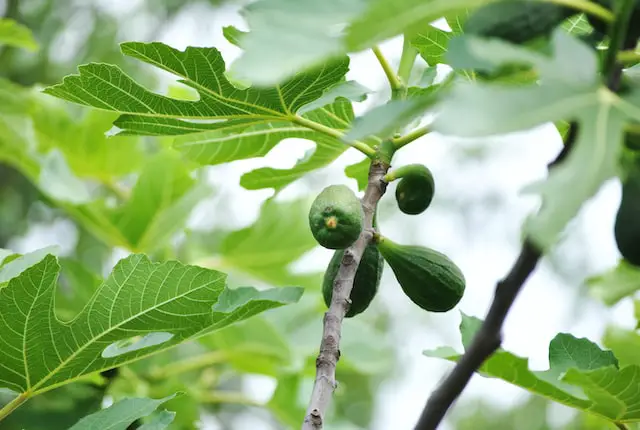
It’s a frustrating gardening scenario: you plant a fig tree, watch it grow, and wait for the first crop of fruit…which never comes. Or it starts to come, but then falls off before ripening. Or maybe you got a good harvest of figs last year, but little to nothing this year. Why does this happen? What is the cause of a fig tree not producing fruit?
Fig trees might not fruit if they are under stress from drought, overwatering, disease, extreme temperatures, overfertilization, improper pruning, and other factors. A productive fig tree needs to be well established and requires well-draining soil, full sun, and a warm growing season.
In many cases, there is a simple solution to getting fig production back on track. Here are some common reasons why a fig tree might not fruit, and what to do about it.
1. Age
Depending on the age of the fig tree when it was planted, it generally takes 2-3 years before it begins to fruit. A fig tree is considered “adult” by year 5, which is when it should start to produce a more robust harvest.
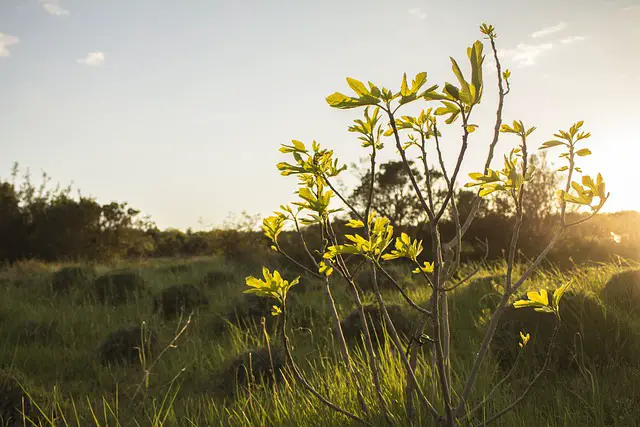
If the tree is too young, it may simply be putting its energy toward establishing a strong root system – which is a good thing for your future fig crop. As the tree matures, it will begin to produce more figs than you know what to do with.
In the right conditions, a fig tree could theoretically fruit indefinitely. Many commercial fig orchards replace their trees after 10-15 years, but that is largely due to managing the size and productivity of the trees. If space isn’t an issue (and depending on the variety), a fig tree can keep growing and producing well into “old age.” (The Lifespan of a Fig Tree: How Long Will it Bear Fruit?)
What to Do:
Just wait! If you’ve provided what the fig tree needs – a sunny location, well-draining soil, and room to grow – it will reward you with a delicious harvest. If the tree still has problems fruiting, then read on for more troubleshooting ideas.
2. Light
Any fig tree plant tag or “how to grow” article will state that a fig tree needs full sun – at least 6-8 hours – to thrive. But it’s not just that you need to place the tree in a sunny spot; for maximum fig potential, each individual branch needs plenty of sun to set fruit. (Where to Plant a Fig Tree: Location Matters)
The first crop of figs form on branches as the tree is growing and leafing out. Each individual leaf node has the potential to form a fig. If the branches are blocked from the sun, then no fig will grow on that branch (or a figlet will set, but drop prematurely).
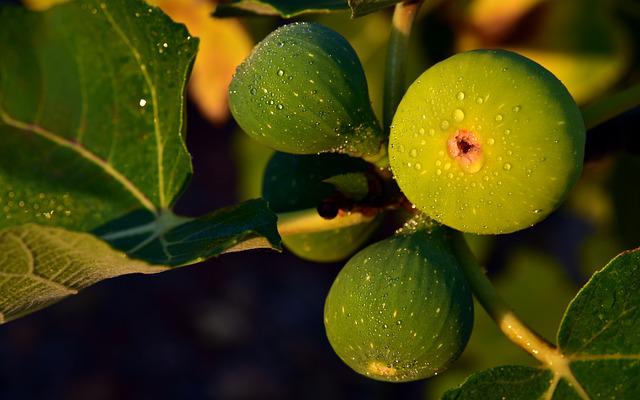
What to Do:
Look at the form of the tree and see if there is any internal shading (even if your tree is in full sun). Branches that are too close together can shade each other. To fix this, either stake individual branches to spread them out, or prune any internal, crossing, or close-together branches.
3. Too Much Fertilizing
Fertilizing is a good thing, right? Well, it turns out, with fig trees less may be more. Figs originated in the Middle East and Mediterranean (they were popular delicacies in ancient Egypt), where the soil is lean and fairly dry.
Fig trees have developed aggressive, far-reaching roots that can seek out water and nutrients. Having to work so hard to find nutrients can actually help a tree to fruit better. Setting fruit is a survival instinct of the tree – if it’s under some stress, then the tree knows it’s time to reproduce (ie, make figs).
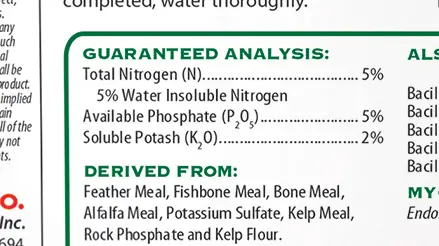
If the soil is too fertile and nutrient rich, or if the roots extend under a well-fertilized lawn, then the tree can absorb too much nitrogen. Nitrogen (the “N” of the “NPK” numbers on the back of a fertilizer bag) encourages leafy growth, and too much can signal the tree to keep making greenery, not fruit.
The vigorous growth that an excess of nitrogen causes can also make the fig tree grow too fast. This weakens the tree, causing splits or cracks in the trunk and branches. These cracks make the tree more susceptible to disease or damage from the cold.
What to Do:
In most cases, a fig tree planted in the ground needs little to no additional fertilizer. If you have very sandy, dry soil, the tree may benefit from a feeding or two – one right at the start of the growing season, and another when the fruit sets. But when in doubt, less is more when it comes to fertilizing in-ground fig trees. (Fertilizing Fig Trees: 8 Times its NOT Necessary)
It’s a different story when it comes to fertilizing potted fig trees. Read on to see if a lack of nutrients may be affecting your container-grown fig tree.
4. Not Enough Fertilizing
Fig trees can still produce a good crop of fruit when grown in a pot. However, a container is an unnatural environment for the tree. The roots have less room to spread, and there are fewer available nutrients for the tree to absorb. It’s up to the gardener to provide the food and water the plant needs.
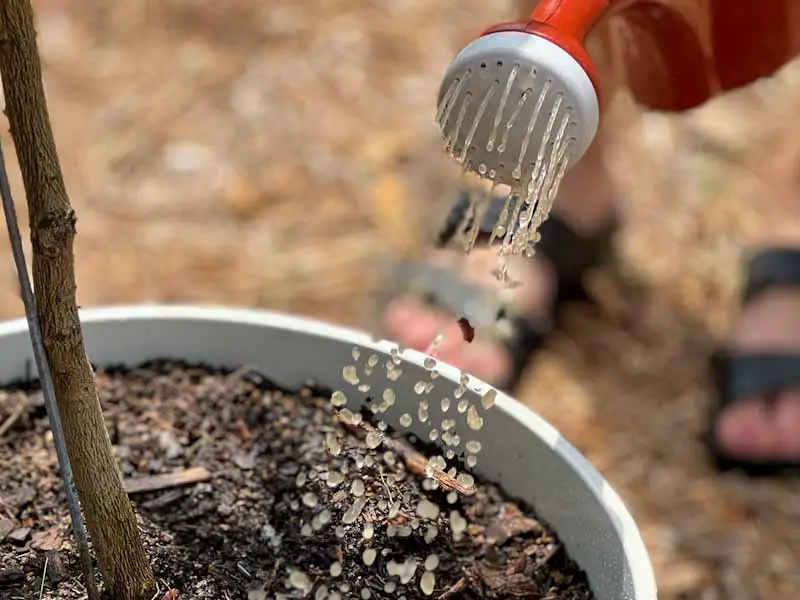
A regular fertilizing schedule is essential for potted fig trees. The best all-around fertilizer to use is a soluble (liquid) formula with a balanced NPK (nitrogen, phosphorous, potassium) ratio, such as 10-10-10 or 5-5-5.
Nitrogen encourages the plant to branch and leaf out in the spring. Phosphorus supports fruit and flower production. Potassium is an essential element for overall plant health.
What to Do:
For potted fig trees, fertilize at least 3 times per season, but no more than once a month: early spring (when the first green shoots appear), late spring (when figlets form), and early summer (as the figs grow and ripen). (When to Fertilize Fig Trees: A Complete Guide)
Many growers recommend fertilizing in-ground trees right at the start of the growing season with a slow-release, balanced, organic granular fertilizer. As mentioned above, if your soil is very lean and sandy, it may help to add a feeding or two later in the season (as the figs set and ripen).
5. Water Stress
Water stress of any kind, whether too much or too little, can cause huge problems for a fig tree. Not enough water puts the tree into survival mode, so its energy goes to staying alive instead of producing fruit. Fig trees like warm weather, but they may need additional watering during long hot stretches so they don’t prematurely drop their fruit.
Too much water can cause root rot and disease, both for in-ground and potted fig trees. Again, figs come from the Mediterranean; too much moisture in soggy, heavy soil will keep a fig tree from thriving or can kill it altogether. Even in well-drained soil (especially in pots), too much water will flush out nutrients and cause health issues for the tree.
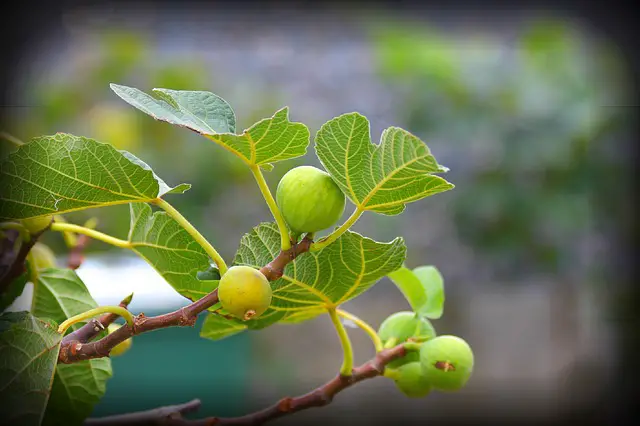
What to Do:
Yellow leaves can be a sign that a fig tree needs more water. Pots may need daily watering in the summer – twice a day, if very hot. Stick a finger in the soil, and water if the top 1-2 inches of the pot are dry. Make sure containers have drainage holes in the bottom to prevent root rot from excess moisture.
For in-ground fig trees, you may want to supplement water during long periods of drought (perhaps once a week). A young tree in the ground will need more regular watering for the first year to help it get established. After that, a deep watering every 2 weeks or so (depending on rainfall), is all the fig tree needs, if anything.
For both potted and in-ground fig trees, a layer of mulch or compost can help prevent the soil from drying out as quickly.
6. Wrong Pruning Habits
Some fig cultivars produce two crops per season: the early (breba) crop fruits on old wood from the previous year, and the main, later crop forms on this year’s new branches. Other cultivars only have one main crop on new growth. Find out which type you have, to prevent inadvertently pruning in a way that harms fruit production.
Pruning a fig tree at different times of year signals the plant hormones to react in different ways. Winter pruning encourages new spring growth, while light pruning in the spring or summer can increase fruiting.
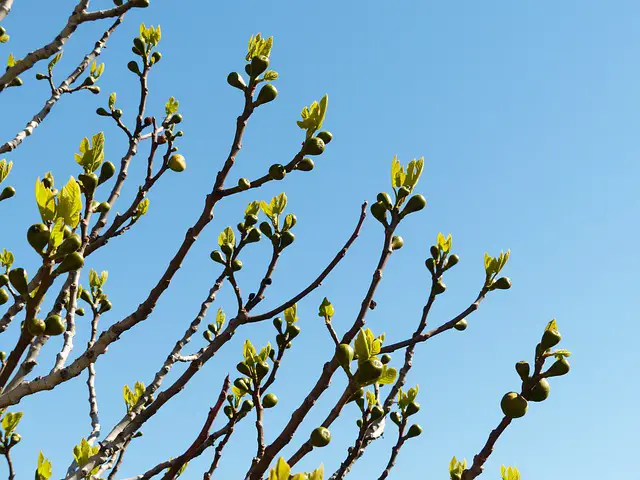
If you do very hard pruning in the winter – for example, if a large portion of the tree dies due to frost damage – then you may not get any figs that year. The tree will most likely grow vigorously and send out many new branches, but it probably won’t fruit.
Some growers recommend “pinching” the buds of growth at the tips of new branches to encourage fruiting. This practice is not necessary for producing a good harvest, but it may be helpful in setting fruit sooner if you live in an area with a short growing season. (Here is a link to a great video by The Millenial Gardener on when, why, and how to pinch fig trees.)
What to Do:
In general, fig trees need little to no pruning. When a tree is young, pruning so that the tree has only 3 or 4 main branches could help with future fruit production. Other than that, a light winter pruning may be all that’s necessary to remove dead wood or crossing/rubbing branches.
Avoid pruning during the growing season if possible. Too much pruning at this stage is more likely to stress the plant than help it. At most, simply remove any unhealthy growth to lessen the spread of diseases, such as leaf rust.
7. Heat Stress
Figs love the heat, and they need a certain amount of warmth and sun to fruit their best. Most varieties do best in warmer climates where the growing season is long enough for the fruit to fully ripen on the tree. A higher soil temperature in the ground or container will help the fig tree perform better and fruit more prolifically.
Beware of long hot, dry spells for container-grown figs. Too much heat, particularly without frequent watering, can burn the roots of a potted fig tree.
What to Do:
In colder growing zones, move potted figs to a sunny, warm location in the spring. Darker pots can help absorb heat and warm the soil. Figs need a certain amount of warm weather to ripen, so areas with a short growing season may need to place trees in a warmer spot. Fig trees can be planted near a south-facing wall or fence to help create a warmer microclimate for the tree and extend the growing season.
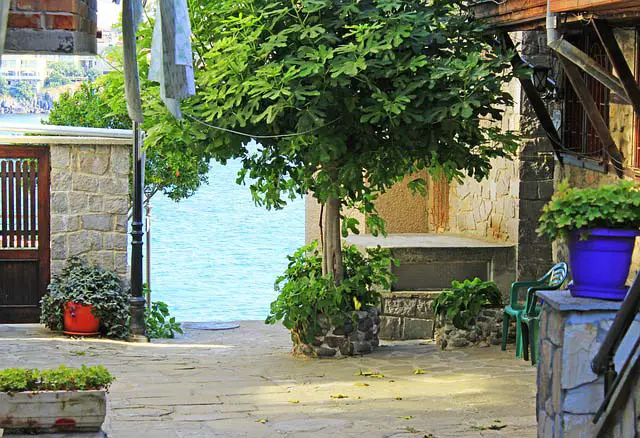
For hotter climates, fig trees planted in the ground will tolerate the heat well. (Just be sure to do some supplemental watering in long periods of drought). A potted tree may stay cooler if planted in a light-colored pot, and will need to be watered frequently in hot, sunny weather. A layer of mulch or compost on top of the pot or around the base of an in-ground tree will help cool the soil.
8. Cold Weather Damage
Fig trees are very susceptible to damage from extreme cold (under about 20° F). Most common fig cultivars are cold-hardy only in milder climates (USDA zone 7 or warmer), but there are some more cold-hardy varieties, such as ‘Chicago Hardy’ (which can be grown successfully up to zone 5).
Even the most cold-tolerant figs can sustain heavy damage in extreme weather. A prolonged freeze may cause part (or all) of the dormant fig tree to die back. The roots may survive, but the tree won’t reliably produce fruit if it has to regrow all of its branches and leaves every year.
In any climate, a late frost could kill the new figlets that emerge in spring. Loss of these fruiting buds will set back fruit production for the season, if not prevent it altogether. If a spring frost is expected, the tree can be covered to protect delicate new growth.
What to Do:
First, choose a good variety for your climate. If you live in a colder zone, choose a cultivar that is developed to be cold-tolerant (such as ‘Chicago Hardy’, ‘Brown Turkey’, ‘Celeste’, or ‘Desert King’).
The best way to protect fig trees from cold is to plant them in containers. (Read “Potted vs. In-Ground Fig Trees: Which is Better?” to see which option is best for you.) Potted figs can easily be moved to a sheltered, non-heated location before the first frost, and then moved back outside in the spring.
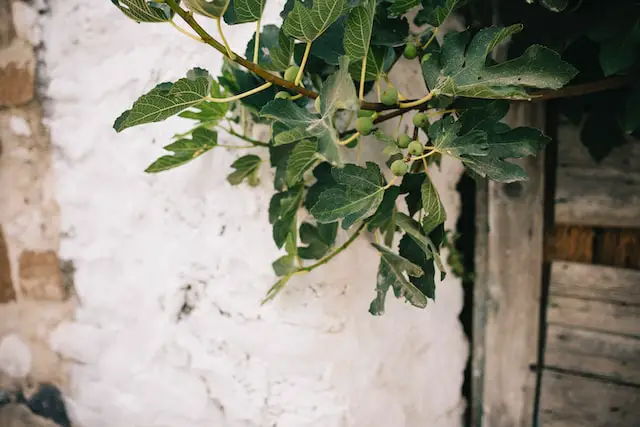
Plant in-ground fig trees in front of a south-facing wall or fence; the wall will reflect heat and help protect trees from the cold. Spread a thick layer of mulch around the base of the tree to insulate the shallow roots when cold sets in. An in-ground fig can also be wrapped with burlap, an old blanket, or other material that will protect it from frost without trapping too much moisture.
Watch the weather carefully for signs of late frost in spring. Bring out potted fig trees only after you are sure there is no danger of frost. Cover in-ground trees to protect any early spring growth from frost damage.
9. Disease
Fig trees are generally easy to care for, but they are susceptible to many diseases that can affect fruit production – such as leaf blight, rust, fig mosaic virus, and root-knot nematodes.
Leaf blight will look like yellow watery spots on the leaves, which will eventually shrivel and turn brown. Pink blight causes a pinkish fuzzy fungus to grow on branches, leading the attached twigs and leaves to wilt and die. Severe blight infections can also cause symptoms to show on the fruit. If blight is caught early, spraying with neem oil can help it from spreading further.
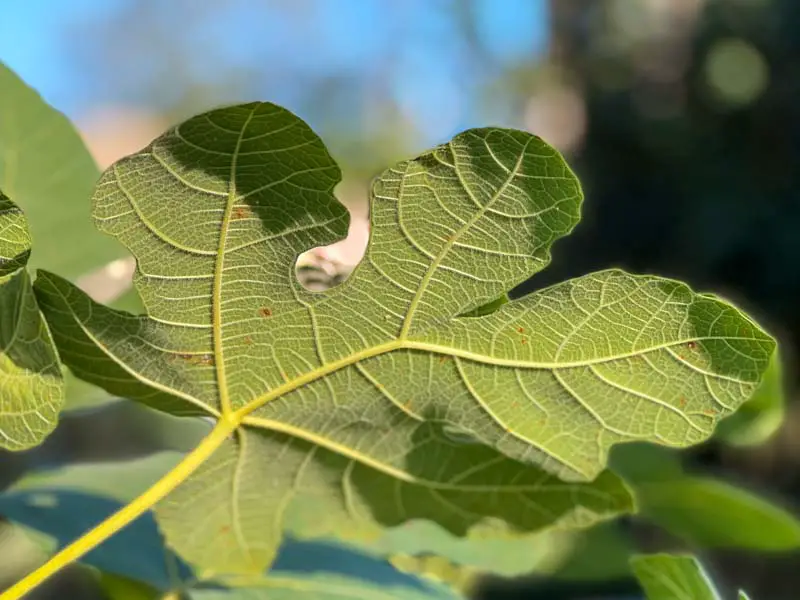
Leaf rust shows up as small rusty-brown spots on the underside of the leaves, which eventually turn yellow and fall off. Rust does not usually kill the tree, but infections year after year can decrease the vigor of the plant.
Fig mosaic virus appears first as yellow spots on some leaves, which then turn into reddish-brown bands. The figs themselves may be spotted, stunted, or drop off the tree before ripe. Unfortunately, there is no cure for fig mosaic virus, so an infected tree must be removed.
Root-knot nematodes (RKN) are microscopic roundworms that infect the roots of the tree and will eventually kill the plant. Fig trees infected with RKN gradually decline, becoming less vigorous in growing and producing fruit.
What to Do:
Prevention is the biggest weapon you have against fig tree diseases. Remove diseased branches, infected leaves and fruit, and clear away debris from the ground. In the winter, prune internal growth to help with air circulation. Avoid getting the leaves wet when watering the tree – the moisture encourages fungus to grow.
Companion plants can help ward off potential disease. Marigolds, in particular, secrete a chemical in their roots that repels root-knot nematodes. (Fig Companion Plants: What to Plant and What to Avoid)
An overall healthy plant will be less susceptible to disease than one that is stressed by temperature or over-/underwatering. Get in the habit of watching your fig tree for signs of distress or symptoms of disease.
10. Soil Health
Any tree needs access to the right nutrients to grow and fruit its best. A fig tree planted in soil that is heavy with clay, waterlogged, or overly fertile may struggle to produce figs. Soil that is too lean, dry, or sandy isn’t ideal either, as the tree may not find enough nutrition to support fruiting.
Either way – if a fig tree is struggling to get enough nutrients in sandy soil, or if the roots can’t spread easily or become rotted in heavy, wet soil – problems with the soil might mean problems with fruit production.

For potted fig trees, the best soil isn’t soil at all – it’s a soilless growing medium. Garden soil can introduce pests or diseases to potted plants and may become waterlogged in the pot, causing root rot. Read this article for more details on how to choose or make the best growing mix for potted figs.
What to Do:
The best way to improve your soil is to help the microbiome (the tiny bacteria, fungus, and other microorganisms that break down organic material and make nutrients available to plants). Layer finished compost around the tree (in-ground or potted) a couple of inches away from the trunk so as not to trap moisture.
Many fig growers recommend using compost tea (which is basically compost soaked and fermented in water, then strained), especially for containers. This will make macro- and micronutrients more available to the plant and boost its ability to fight disease. It’s like a multivitamin for the fig tree.
11. Pollination Problem
There are four main categories of fig trees: Common, Caprifig, Smyrna (or Caducous), and San Pedro. Most commercially available fruiting fig varieties fall in the “common fig” category, and these do not require pollination to fruit.
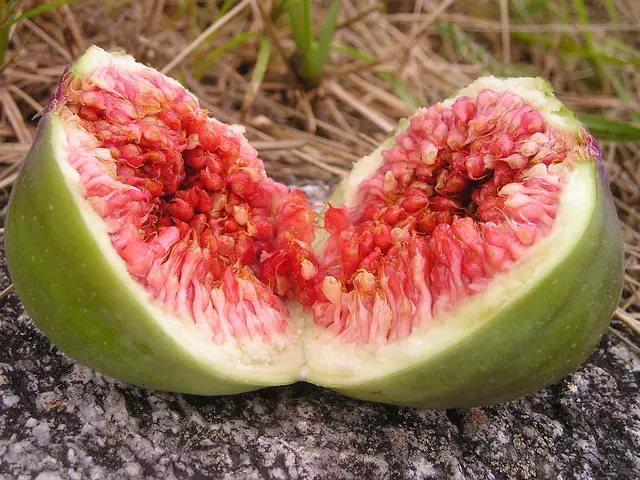
The fruit of common figs forms by parthenocarpy (without fertilization), although there is some evidence that pollination can improve the size and quality of the figs.
However, “Smyrna” and “San Pedro” type figs can only develop with the help of pollination from a “caprifig” tree, which produces inedible fruits. The tiny Blastophaga wasp, or fig wasp, is responsible for pollinating these varieties.
Examples of fig cultivars that need pollination include ‘Zidi’, ‘San Pedro’, and ‘Calimyrna’ (or ‘Sari Lop’). The latter variety is what Fig Newtons are made with and is largely grown in central California.
What to Do:
Know your fig! If it is a “common” fig tree variety, which is likely, then pollination is not necessary for a good fig harvest.
“Smyrna” or “San Pedro” figs need help from a “caprifig” to produce fruit. The fig wasp makes its home in caprifig flowers and will carry the pollen to the other trees. “Smyrna” figs will produce an early (often inferior) breba crop without being pollinated, but the later main crop will require fertilization.
